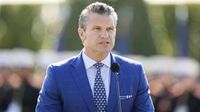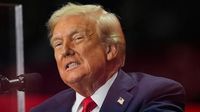On a brisk autumn morning at the Marine Corps Museum in Quantico, Virginia, nearly 800 of the United States military’s highest-ranking officers gathered for what would become one of the most controversial assemblies of senior leadership in recent memory. Ordered to appear with little explanation, generals, admirals, and senior enlisted leaders from across the globe were left speculating about the purpose of the unprecedented meeting. According to Raw Story, the event broke with long-standing military protocol—such briefings are typically conducted via recorded messages, both to accommodate time zone differences and to avoid the security risk of concentrating so much of the military’s leadership in one place.
Instead of the strategic announcements or policy shifts many anticipated, the assembled leaders were treated to a pair of speeches that left more questions than answers. Secretary of Defense Pete Hegseth opened the event with remarks that, as reported by both Raw Story and other outlets, focused heavily on traditional military discipline—emphasizing physical fitness, grooming standards, and a return to what he called "the highest male standard" for combat positions. Hegseth, a veteran of the Princeton University ROTC and the Minnesota Army National Guard, appeared to channel a drill instructor rather than a peer addressing a room filled with a collective 25,000 years of military experience.
Hegseth’s rhetoric was pointed and, to many, patronizing. He denounced what he described as "toxic leaders" who had lowered standards through diversity, equity, and inclusion efforts, and he championed a regressive vision for the military. According to Raw Story, Hegseth’s speech included the restoration of Confederate imagery and the erasure of accomplishments by anyone who was not a white, cisgender, heteronormative, Christian man from military websites and guides. He did not shy away from controversy, openly calling out “fat troops” and declaring, "It's completely unacceptable to see fat generals and admirals in the halls of the Pentagon and leading commands around the world. It's a bad look."
Yet the atmosphere in the room remained tense and silent. Hegseth’s 40-minute address, intended to be inspiring, was met with a stony silence from the military’s top brass. As one Pentagon reporter, Helene Cooper, observed, no military officials who attended the meeting expressed approval of what they heard—a sentiment echoed widely on social media and among defense analysts.
The event’s main act, however, was President Donald Trump. According to both Raw Story and independent analysts, Trump appeared fatigued, his speech marked by rambling anecdotes, offhand jabs at political opponents, and a tone that oscillated between petulant and ominous. Trump’s remarks veered from complaints about his lack of applause—"I never walked into a room so silent before. This is very–don't laugh, don't laugh. You're not allowed to do that. You know what, just have a good time"—to outright threats: "And if you don't like what I'm saying, you can leave the room. Of course, there goes your rank and there goes your future."
Throughout his lengthy address, Trump criticized his predecessor, repeated controversial claims about an "invasion from within," and floated the idea of using American cities as military training grounds. "The ones that are run by the radical left Democrats... what they've done to San Francisco, Chicago, New York, Los Angeles, they're very unsafe places. And we're going to straighten them out one by one," Trump said, according to Raw Story. He continued, "This is going to be a major part for some of the people in this room. That's a war too. It's a war from within."
Trump also referenced a recent executive order: "Last month, I signed an executive order to provide training for a quick reaction force that can help quell civil disturbances. This is gonna be a big thing for the people in this room, because it's the enemy from within and we have to handle it before it gets out of control. It won't get out of control." He even suggested, "I told Pete, we should use some of these dangerous cities as training grounds for our military. National Guard, but our military. Because we're going into Chicago very soon. That's a big city with an incompetent governor."
The president’s comments were widely interpreted as a threat to deploy military forces against domestic populations in cities led by Democratic officials—a move that alarmed many observers and drew sharp criticism across the political spectrum. Notably, Trump did not mention Republican-led states with high crime rates, a fact that did not go unnoticed by those outside his loyal base.
Observers from both Raw Story and other outlets highlighted the muted, stoic reaction from the assembled officers. The silence, as some put it, was "golden." Social media commentators and military analysts alike described the event as "clownish and dangerous," with the leadership’s lack of response deflating Trump’s expectation of a rousing reception. As Bill Kristol put it, "Trump and Hegseth: At once clownish and dangerous."
Adding to the controversy, Hegseth promoted a return to the Department of War name—a move not officially sanctioned by Congress—and unveiled ten new directives for physical fitness and grooming, further stoking discontent among the ranks. His public denouncement of notable retired generals was seen as a breach of military protocol and an affront to those who had earned their respect through decades of service.
Several attendees and commentators pointed out the irony of Hegseth’s position. With relatively limited experience compared to the collective expertise in the room, his lecture on military fundamentals struck many as inappropriate, if not outright disrespectful. The event, intended to project strength and unity, instead exposed deep rifts between the administration’s leadership and the military’s seasoned professionals.
Neither Trump nor Hegseth addressed the looming government shutdown—a topic of immediate concern to the assembled leaders, as active-duty troops are required to report for duty during a shutdown but do not receive pay until it is resolved. The omission was glaring, especially given the impact of the last government shutdown in 2018, during Trump’s first term.
For many veterans and military leaders, the gathering was a sobering reflection of the current administration’s approach to military leadership and strategy. As reported by both Raw Story and independent journalists, a sense of disenchantment permeated the room. The leadership on display, they felt, fell far short of the respect and gravitas typically accorded to America’s armed forces and their traditions.
As the United States military looks ahead to future challenges, the sentiments expressed—and left unspoken—at Quantico may shape the relationship between civilian leadership and military professionals for years to come. The event, in the eyes of many, underscored a growing divide at the very heart of America’s defense establishment.

